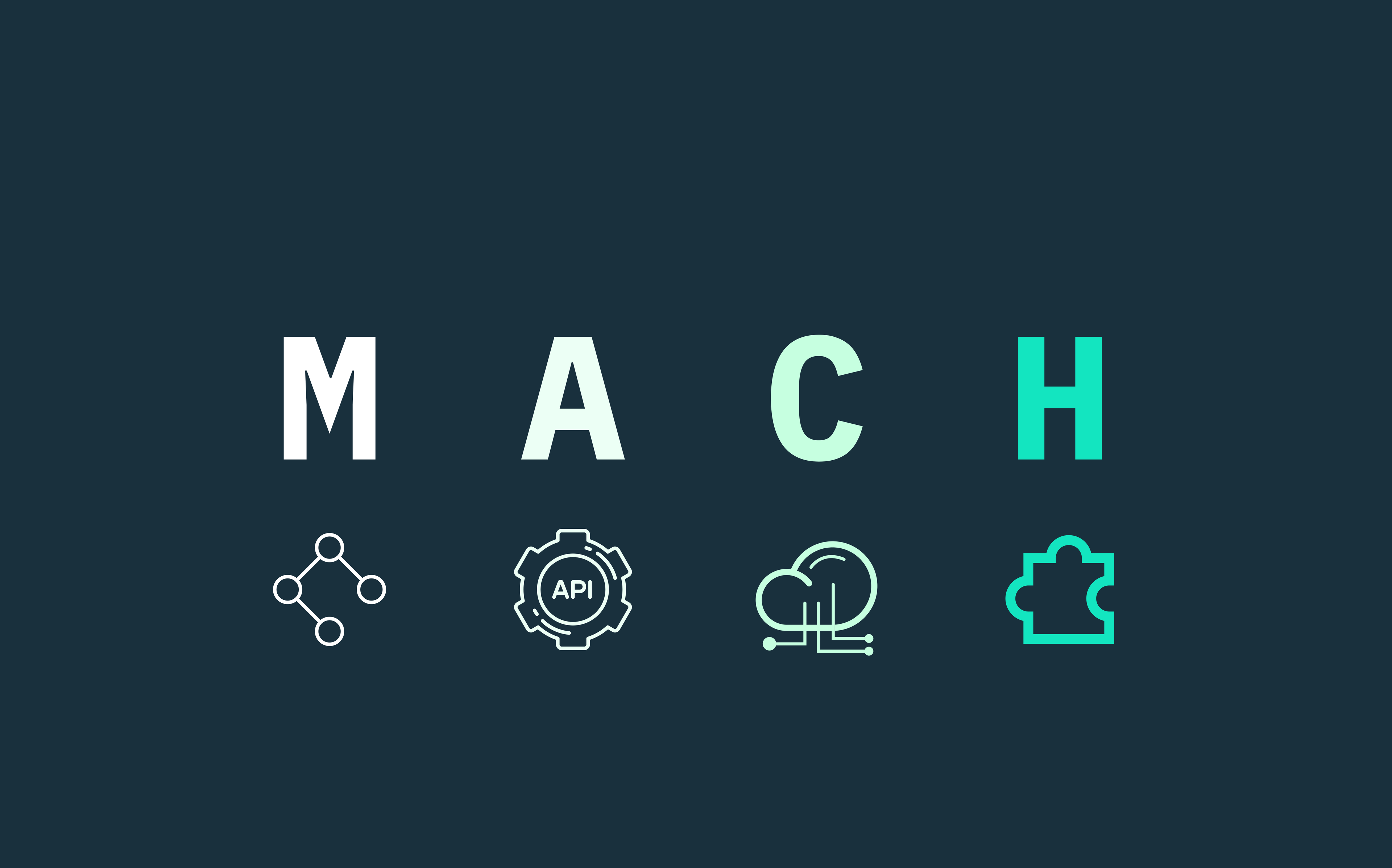Back to blog
Unpacking MACH architecture: The future of SaaS development
Auth & identity
Mar 5, 2024
Author: Alex Lawrence

It goes without saying that successful modern software development necessitates an easily adaptable approach to changing business needs and customer expectations.
Enter MACH architecture, a set of principles advocated by the MACH alliance that is reshaping how developers build, deploy, and manage applications. This article explains the MACH architecture, breaking down its components – Microservices, API-first, Cloud-native, and Headless – while exploring its benefits, challenges, and the best practices in applying MACH principles to SaaS applications.
The essence of MACH architecture
Founded in 2020, the MACH Alliance is a collective of tech companies advocating for MACH architecture development and MACH principles in digital solutions, and includes notable members like Adobe, AWS, Google Cloud, and Contentstack. Together, the alliance sets standards and shares best practices towards creating interoperability and open technology frameworks that are the backbone of MACH architecture.
Modularity, agility, scalability
MACH architecture is increasingly recognized as a transformative framework that offers a modular, agile, and scalable foundation for crafting software applications. The framework aims to develop adaptable, forward-thinking systems capable of navigating the ever-evolving demands of today’s businesses and consumers. To evaluate MACH architecture as successful, it must facilitate rapid innovation and continuous development so that businesses can seamlessly integrate new technologies and trends to stay competitive.
The essence of MACH architecture lies in its ability to foster a composable development environment, where businesses can easily assemble, tweak, and reassemble various services to create tailored digital experiences that are by and large the expectations of today.
Microservices: Building blocks of agility
At the heart of MACH architecture is the microservices architecture, which advocates for deconstructing the software architecture into small, independently developed services, each dedicated to a specific business functionality. This approach aligns perfectly with the principles of agile development, as it allows individual teams to focus on their areas of expertise, deploying updates and new features without impacting the broader application. By compartmentalizing the various components of an application, businesses can ensure that a failure in one area doesn’t lead to a cascading effect across the entire system. This resilience is particularly important in commerce service platforms, where uptime and performance directly impact customer satisfaction and revenue.
A microservices-based structure is crucial for achieving continuous delivery and scalability, hallmark features of MACH architecture that make it an ideal choice for businesses looking to enhance their software development lifecycle.
API-first: The connectivity glue
The API-first approach, a core tenet of MACH architecture, prioritizes the development of APIs as the fundamental connectors between microservices and the external world. This strategy ensures seamless interaction among the disparate components of a software system, facilitating a cohesive and integrated architecture. In the context of composable development, an API-first methodology enables businesses to swiftly integrate various services, enhancing their ability to bolster their technical infrastructure and offer a rich and seamless customer experience across multiple touchpoints.
Adopting an API-first strategy also simplifies the integration of third-party services and solutions, a common practice in the MACH alliance, where interoperability and collaboration in the broader ecosystem are key. By designing robust and well-documented APIs from the outset, organizations can create a flexible and extensible software architecture that readily adapts to new business needs and opportunities.
Cloud-native: The scalable backbone
Cloud-native development in MACH architecture leverages the full potential of cloud infrastructure to build applications that are inherently scalable, resilient, and easy to manage. This focus on cloud-native apps equips organizations to utilize the cloud’s dynamic resources for optimal performance and cost-efficiency. The principles of cloud-native development, including microservices, containers, and continuous innovation/continuous deployment (CI/CD), are vital for businesses that demand agility and scalability in their digital services.
The cloud-native component of MACH architecture also improves application resilience. By distributing services across cloud environments, businesses can mitigate the impact of system failures for continuous operation and a consistent user experience.
Headless architecture: Freedom to innovate
The headless component of MACH architecture separates the backend logic and data management from the frontend presentation layer to increase flexibility for developers in how content and services are delivered to users. This separation allows developers to innovate on the front end without being constrained by backend complexities, so they can focus on creating bespoke user interfaces tailored to the unique needs of different channels and devices. Whether it’s a web application, mobile app, IoT device, or any other digital touchpoint, the headless approach in MACH architecture supports the development of consistently engaging digital experiences across all platforms.
Headless architecture in MACH technology not only facilitates a more agile and responsive design process but also allows organizations to future-proof their applications by making it easier to adopt new frontend technologies as they emerge. As customer expectations continue to rise, the flexibility and adaptability of the headless approach become increasingly valuable, supporting faster iteration and deployment of new user experiences.
Aside: Stytch’s easy-to-integrate APIs and headless SDKs allow you to build your authentication flows with the agility required to evolve in a MACH architecture environment. Together, these tools make it easier for software developers to innovate and position their products for success in today’s fluid digital environment. Learn more.
The complexities of adopting MACH architecture

While there are many benefits to MACH architecture in meeting the exceptionally high digital experience bar of today’s applications, implementation challenges remain in harnessing the architecture’s full potential. When adopting MACH technology principles, organizations should look at these initial hurdles as necessary strategic challenges paving the way to substantial long-term benefits.
Integration challenges
As discussed, adopting a MACH architecture means embracing a composable service architecture made up of independent components, each responsible for discrete business functionalities. While this modular approach offers enhanced flexibility and scalability, it also introduces complexity in integrating these disparate factors into a cohesive system that MACH technologies support.
The key challenge is ensuring seamless communication and interoperability between microservices, APIs, and headless systems, driven by a well-thought-out strategy for API management and service orchestration. To start, development teams must carefully evaluate MACH technologies to ensure they align with the organization’s technical capabilities and business objectives, ensuring a smooth transition and effective integration once they pull the trigger.
Managing a microservices-based architecture
The shift to a microservices-based architecture involves decomposing traditional monolithic systems into smaller, independently deployable services. This transition enables organizations to enhance agility and speed up time to market. However, it also introduces complexity in managing and orchestrating numerous services, demanding a significant shift in the operational and cultural mindset of development teams.
Adopting a strong DevOps culture and investing in automation for continuous integration and delivery are critical best practices to introduce microservices and mitigate these challenges using MACH architecture. They are not always intuitive and require significant internal resource investments – a barrier for some.
Finally, organizations must ensure their cloud-native infrastructure is robust enough to support the dynamic nature of microservices, facilitating the efficient deployment and scaling of MACH technologies and services.
UX challenges of headless applications
A seamless user experience in headless development requires meticulous planning and execution in designing APIs and selecting front-end technologies that can support diverse presentation requirements.
The detachment of the front-end from the back-end in headless environments, while beneficial for customization and agility, places a greater onus on developers to maintain consistency in user experience (UX). They are challenged with creating a cohesive UX that aligns with the brand across myriad devices and platforms, which requires adeptness in working with APIs and a deep understanding of the end user’s environment. Careful coordination between teams is critical, as even small discrepancies in front-end application behavior can lead to significant inconsistencies in UX.
Additionally, developers must stay abreast of advancements in front-end technologies to ensure that the experience is seamless, responsive, and engaging on all devices. Ensuring the flexibility of the UX without sacrificing performance requires meticulous design and ongoing testing to adapt to the varied ways consumers interact with digital platforms.
The big lift from legacy to composable
The transition to a MACH architecture often involves integrating or replacing legacy infrastructure, which can be a significant hurdle for many organizations. Legacy systems are typically tightly integrated and may not support the modular, API-first approach that MACH architecture advocates. This challenge necessitates a strategic approach to digital transformation, where legacy systems are incrementally refactored or replaced with MACH-compliant solutions. Ensuring a smooth transition requires careful planning and execution, with a focus on minimizing disruption to existing operations while laying the foundation for a future-proof, composable enterprise.
By addressing these challenges with strategic planning and best practices, organizations can successfully navigate the complexities of adopting MACH architecture, ultimately reaping the long-term benefits of enhanced flexibility, scalability, and market responsiveness.
The benefits of MACH-compliant authentication

Perhaps the last, yet equally important, piece of a perfectly defined MACH architecture is secure authentication. An auth platform built on MACH principles is essential in supporting the core tenets of modularity, agility, and scalability that comprise a best-in-class MACH architecture.
Stytch enables developers to implement secure, scalable, and customizable MACH-compliant SaaS authentication services that enhance the user experience and meet evolving business needs with a focus and competency in supporting each core component.
Microservices
Stytch allows for independent development and deployment of authentication features in a microservices environment, using a low-level composable API and a suite of auth primitives designed for maximum flexibility and code control. Such an environment helps your organization rapidly iterate on and deploy new features to meet the intense demands of modern software applications. A microservice architecture also allows for greater scalability and reliability by isolating failures and preventing downtime, creating a resilient and reliable authentication platform for developers and organizations.
API-first
Stytch’s modular API-first design allows developers to easily integrate authentication services into their applications. By following RESTful principles, Stytch’s APIs are intuitive, easy to use, and seamless to integrate. Stytch’s API exposes a comprehensive suite of resource-oriented endpoints that power your application’s identity management and authentication flows. This includes functionality and features like login and signup, invites, user management, session management, and more.
With Stytch, developers and organizations can enjoy the flexibility to choose how they want to implement and manage their authentication services.
Cloud-native
Stytch’s cloud-native architecture provides organizations with the flexibility, scalability, and cost-effectiveness needed to support modern application environments. By leveraging cloud services, Stytch can easily handle spikes in traffic and scale resources as needed, ensuring a seamless user experience and rapid business growth. This also allows for a pay-as-you-go model, reducing infrastructure costs and enabling organizations to only pay for the resources they use.
Headless
Stytch enables front-end and back-end developers to work more efficiently by separating user interfaces from back-end processes. To support headless development, applications can integrate with Stytch’s authentication services via front or backend SDKs without being tied to any specific frontend framework or platform. This results in a more streamlined development process, faster go-to-market, and the ability to design the frontend to meet specific user demands – all while maintaining high-security standards.
Through working with Stytch, businesses can significantly improve their authentication processes, leading to a more securely connected, efficient, and MACH-compliant SaaS environment that fuels an exceptional customer experience for their end users. Get started building today or reach out to an auth expert to learn more.
Build auth with Stytch
Pricing that scales with you • No feature gating • All of the auth solutions you need plus fraud & risk
Authentication & Authorization
Fraud & Risk Prevention
© 2025 Stytch. All rights reserved.


